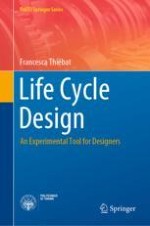2019 | OriginalPaper | Chapter
4. Defining an Innovative Design Method Based on the Life Cycle Approach
Author : Francesca Thiébat
Published in: Life Cycle Design
Publisher: Springer International Publishing
Activate our intelligent search to find suitable subject content or patents.
Select sections of text to find matching patents with Artificial Intelligence. powered by
Select sections of text to find additional relevant content using AI-assisted search. powered by
